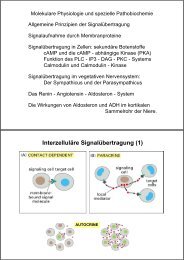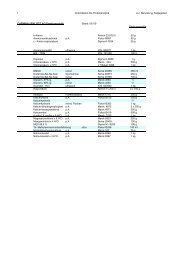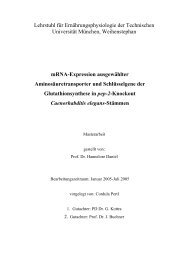Review The role of insulin and IGF-1 signaling in longevity
Review The role of insulin and IGF-1 signaling in longevity
Review The role of insulin and IGF-1 signaling in longevity
Create successful ePaper yourself
Turn your PDF publications into a flip-book with our unique Google optimized e-Paper software.
CMLS, Cell. Mol. Life Sci. Vol. 62, 2005 <strong>Review</strong> Article 325<br />
Metabolism <strong>and</strong> <strong><strong>in</strong>sul<strong>in</strong></strong>-receptor <strong>and</strong> <strong>IGF</strong> 1-receptor<br />
<strong>signal<strong>in</strong>g</strong><br />
S<strong>in</strong>ce the discovery <strong>of</strong> <strong><strong>in</strong>sul<strong>in</strong></strong> <strong>in</strong> 1921, most studies have<br />
focused on the <strong>role</strong> <strong>of</strong> this hormone <strong>in</strong> metabolism <strong>and</strong><br />
glucose homeostasis [139, 140]. However, both obesity<br />
<strong>and</strong> diabetes are associated with shortened life expectancy<br />
[141–144]. Both <strong>of</strong> these disorders are also on<br />
the rise <strong>in</strong> <strong>in</strong>dustrialized countries due to more sedentary<br />
lifestyles <strong>and</strong> higher caloric <strong>in</strong>take throughout the civilized<br />
world.<br />
Studies over the last several years have revealed a central<br />
<strong>role</strong> <strong>of</strong> <strong><strong>in</strong>sul<strong>in</strong></strong> <strong>signal<strong>in</strong>g</strong> <strong>in</strong> lifespan <strong>and</strong> ag<strong>in</strong>g <strong>in</strong> diverse<br />
organisms, rang<strong>in</strong>g from yeast to rodents. <strong>The</strong>se discoveries<br />
<strong>in</strong>dicate that ag<strong>in</strong>g is a programmed <strong>and</strong> well-controlled<br />
process regulated by the same pathways that affect<br />
growth, development <strong>and</strong> metabolism <strong>in</strong> these organisms.<br />
This supports the hypothesis that the impact <strong>of</strong> these<br />
genes on <strong>longevity</strong> <strong>of</strong> different species is an evolutionarily<br />
conserved process (fig. 2).<br />
Calorie restriction<br />
<strong>The</strong> most strik<strong>in</strong>g <strong>and</strong> the most consistent model <strong>of</strong> extended<br />
lifespan, <strong>and</strong> one which dramatically demonstrates<br />
the <strong>role</strong> <strong>of</strong> metabolism <strong>in</strong> this process, is calorie restriction.<br />
Indeed, calorie restriction retards ag<strong>in</strong>g <strong>and</strong> extends<br />
median <strong>and</strong> maximal lifespan <strong>in</strong> yeast, worms, fish,<br />
flies, mice, rats <strong>and</strong> monkeys [145–148], <strong>and</strong> recent data<br />
suggest even <strong>in</strong> humans [148].<br />
Some <strong>of</strong> the common <strong>and</strong> consistent effects <strong>of</strong> calorie restriction<br />
<strong>in</strong> rodents <strong>and</strong> nonhuman primates <strong>in</strong>clude lower<br />
fat mass, particularly visceral fat, lower circulat<strong>in</strong>g <strong>in</strong>su-<br />
l<strong>in</strong> <strong>and</strong> <strong>IGF</strong>-1 concentrations, <strong>in</strong>creased <strong><strong>in</strong>sul<strong>in</strong></strong> sensitivity,<br />
lower body temperature, lower fat-free mass, lower<br />
sedentary energy expenditure (adjusted for fat-free<br />
mass), decreased levels <strong>of</strong> thyroid hormones <strong>and</strong> decreased<br />
oxidative stress (table 1) [149]. In addition, calorie<br />
restriction <strong>in</strong> young animals delays sexual maturation,<br />
but this seems unrelated to the <strong>in</strong>creased lifespan, s<strong>in</strong>ce<br />
calorie restriction has the same effect when <strong>in</strong>itiated <strong>in</strong><br />
older animals [150, 151]. Reduced metabolism <strong>and</strong> the<br />
consequent reduction <strong>of</strong> free-radical production is another<br />
possible explanation for the anti-ag<strong>in</strong>g effects <strong>of</strong><br />
calorie restriction. However, other effects <strong>of</strong> calorie restriction,<br />
such as lower body temperature, <strong>in</strong>creased <strong><strong>in</strong>sul<strong>in</strong></strong><br />
sensitivity, decreased <strong><strong>in</strong>sul<strong>in</strong></strong>/<strong>IGF</strong>-1 levels, sympathetic<br />
nervous system activity, <strong>and</strong> altered gene expression<br />
<strong>in</strong> muscle, heart <strong>and</strong> bra<strong>in</strong> <strong>of</strong> calorie-restricted<br />
animals, have all been suggested to play a <strong>role</strong> <strong>in</strong> the effects<br />
<strong>of</strong> calorie restriction on <strong>longevity</strong>. Calorie restricted<br />
monkeys also have <strong>in</strong>creased dehydroepi<strong>and</strong>rosterone<br />
sulfate [145], <strong>and</strong> this has been suggested as a possible<br />
marker <strong>of</strong> <strong>longevity</strong> <strong>in</strong> humans [152, 153].<br />
Because <strong>of</strong> the difficulties <strong>in</strong>volved <strong>in</strong> conduct<strong>in</strong>g longterm<br />
calorie restriction studies, <strong>in</strong>clud<strong>in</strong>g ethical <strong>and</strong><br />
methodological considerations, there is little <strong>in</strong>formation<br />
on the effects <strong>of</strong> calorie restriction <strong>in</strong> humans on actual<br />
lifespan. <strong>The</strong>re have been some naturally occurr<strong>in</strong>g<br />
episodes <strong>of</strong> calorie restriction <strong>in</strong> human populations, although<br />
these usually <strong>in</strong>volve exposure to diets lack<strong>in</strong>g<br />
prote<strong>in</strong> <strong>and</strong> micronutrients [149]. In these cases, calorie<br />
restriction is <strong>of</strong>ten associated with short stature, late reproductive<br />
maturation, lower gonadal steroid production<br />
<strong>in</strong> adults, suppressed ovarian function [154], impaired<br />
lactation performance [155], impaired fecundity <strong>and</strong> im-<br />
Figure 2. Conserved regulation <strong>of</strong> <strong>longevity</strong>. In different organisms, the conserved glucose or <strong><strong>in</strong>sul<strong>in</strong></strong>/<strong>IGF</strong>-1-like pathways downregulate<br />
antioxidant enzymes <strong>and</strong> heat shock prote<strong>in</strong>s, reduce the accumulation <strong>of</strong> glycogen or fat <strong>and</strong> <strong>in</strong>crease growth <strong>and</strong> mortality. Decreased activity<br />
<strong>of</strong> these pathways extends <strong>longevity</strong> by simulat<strong>in</strong>g calorie restriction. Modified from [336].









